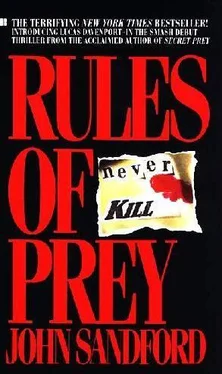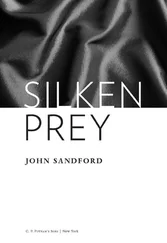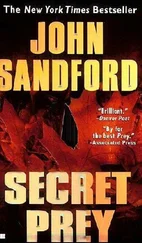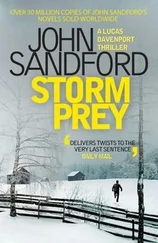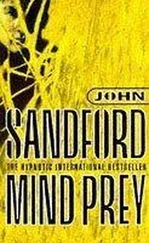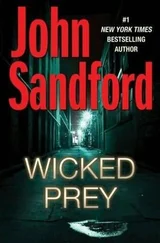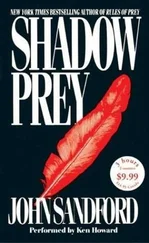
John Sandford
Rules of Prey
The first book in the Lucas Davenport series
A rooftop billboard cast a flickering blue light through the studio windows. The light ricocheted off glass and stainless steel: an empty crystal bud vase rimed with dust, a pencil sharpener, a microwave oven, peanut-butter jars filled with drawing pencils, paintbrushes and crayons. An ashtray full of pennies and paper clips. Jars of poster paint. Knives.
A stereo was dimly visible as a collection of rectangular silhouettes on the window ledge. A digital clock punched red electronic minutes into the silence.
The maddog waited in the dark.
He could hear himself breathe. Feel the sweat trickle from the pores of his underarms. Taste the remains of his dinner. Feel the shaven stubble at his groin. Smell the odor of the Chosen 's body.
He was never so alive as in the last moments of a long stalk. For some people, for people like his father, it must be like this every minute of every hour: life on a higher plane of existence.
The maddog watched the street. The Chosen was an artist. She had smooth olive skin and liquid brown eyes, tidy breasts and a slender waist. She lived illegally in the warehouse, bathing late at night in the communal rest room down the hall, furtively cooking microwave meals after the building manager left for the day. She slept on a narrow bed in a tiny storage room, beneath an art-deco crucifix, immersed in vapors of turpentine and linseed. She was out now, shopping for microwave dinners. The microwave crap would kill her if he didn't, the maddog thought. He was probably doing her a favor. He smiled.
The artist would be his third kill in the Cities, the fifth of his life.
The first was a ranch girl, riding out of her back pasture toward the wooded limestone hills of East Texas. She wore jeans, a red-and-white-checked shirt, and cowboy boots. She sat high in a western saddle, riding more with her knees and her head than with the reins in her hand. She came straight into him, her single blonde braid bouncing behind.
The maddog carried a rifle, a Remington Model 700 ADL in.270 Winchester. He braced his forearm against a rotting log and took her when she was forty yards out. The single shot penetrated her breastbone and blew her off the horse.
That was a killing of a different kind. She had not been Chosen; she had asked for it. She had said, three years before the killing, in the maddog's hearing, that he had lips like red worms. Like the twisting red worms that you found under river rocks. She said it in the hall of their high school, a cluster of friends standing around her. A few glanced over their shoulders at the maddog, who stood fifteen feet away, alone, as always, pushing his books onto the top shelf of his locker. He gave no sign that he'd overheard. He had been very good at concealment, even in his youngest days, though the ranch girl didn't seem to care one way or another. The maddog was a social nonentity.
But she paid for her careless talk. He held her comment to his breast for three years, knowing his time would come. And it did. She went off the back of the horse, stricken stone-cold dead by a fast-expanding copper-jacketed hunting bullet.
The maddog ran lightly through the woods and across a low stretch of swampy prairie. He dumped the gun beneath a rusting iron culvert where a road crossed the marsh. The culvert would confuse any metal detector used to hunt for the weapon, although the maddog didn't expect a search-it was deer season and the woods were full of maniacs from the cities, armed to the teeth and ready to kill. The season, the weapon cache, had all been determined far in advance. Even as a sophomore in college, the maddog was a planner.
He went to the girl's funeral. Her face was untouched and the top half of the coffin was left open. He sat as close as he could, in his dark suit, watched her face and felt the power rising. His only regret was that she had not known that death was coming, so that she might savor the pain; and that he had not had time to enjoy its passage.
The second killing was the first of the truly Chosen, although he no longer considered it a work of maturity. It was more of… an experiment? Yes. In the second killing, he remedied the deficiencies of the first.
She was a hooker. He took her during the spring break of his second year, the crisis year, in law school. The need had long been there, he thought. The intellectual pressure of law school compounded it. And one cool night in Dallas, with a knife, he earned temporary respite on the pale white body of a Mississippi peckerwood girl, come to the city to find her fortune.
The ranch girl's shooting death was lamented as a hunting accident. Her parents grieved and went on to other things. Two years later the maddog saw the girl's mother laughing outside a concert hall.
The Dallas cops dismissed the hooker's execution as a street killing, dope-related. They found Quaaludes in her purse, and that was good enough. All they had was a street name. They put her in a pauper's grave with that name, the wrong name, on the tiny iron plaque that marked the place. She had never seen her sixteenth year.
The two killings had been satisfying, but not fully calculated. The killings in the Cities were different. They were meticulously planned, their tactics based on a professional review of a dozen murder investigations.
The maddog was intelligent. He was a member of the bar. He derived rules.
Never kill anyone you know.
Never have a motive.
Never follow a discernible pattern.
Never carry a weapon after it has been used.
Isolate yourself from random discovery.
Beware of leaving physical evidence.
There were more. He built them into a challenge.
***
He was mad, of course. And he knew it.
In the best of worlds, he would prefer to be sane. Insanity brought with it a large measure of stress. He had pills now, black ones for high blood pressure, reddish-brown ones to help him sleep. He would prefer to be sane, but you played the hand you were dealt. His father said so. The mark of a man.
So he was mad.
But not quite the way the police thought.
He bound and gagged the women and raped them.
The police considered him a sex freak. A cold freak. He took his time about the killings and the rapes. They believed he talked to his victims, taunted them. He carefully used prophylactics. Lubricated prophylactics. Postmortem vaginal smears on the first two Cities victims produced evidence of the lubricant. Since the cops never found the rubbers, they assumed he took them with him.
Consulting psychiatrists, hired to construct a psychological profile, believed the maddog feared women. Possibly the result of a youthful life with a dominant mother, they said, a mother alternately tyrannical and loving, with sexual overtones. Possibly the maddog was afraid of AIDS, and possibly-they talked of endless possibilities-he was essentially homosexual.
Possibly, they said, he might do something with the semen he saved in the prophylactics. When the shrinks said that, the cops looked at each other. Do something? Do what? Make Sno-Cones? What?
The psychiatrists were wrong. About all of it.
He did not taunt his victims, he comforted them; helped them to participate. He didn't use the rubbers primarily to protect himself from disease, but to protect himself from the police. Semen is evidence, carefully collected, examined, and typed by medical investigators. The maddog knew of a case where a woman was attacked, raped, and killed by one of two panhandlers. Each man accused the other. A semen-typing was pivotal in isolating the killer.
Читать дальше
